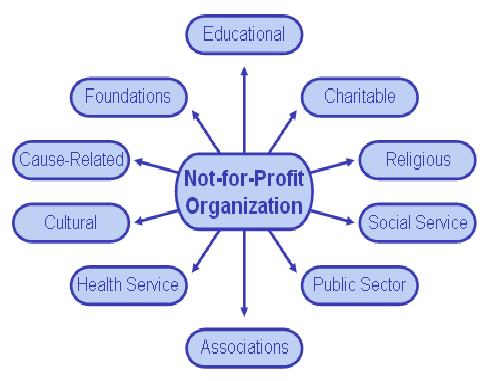Not-for-Profit (NFP): An organization that provides some service or good with no intention of earning a profit. NFP includes Private nonprofit corporations (such as hospitals, institutes, private colleges, and organized charities) as well as Public governmental units/agencies (such as welfare departments, prisons, and state universities)
Types of Not-for-Profit Organizations
Importance of Revenue Source: NFPs are dependant on dues, assessments, or donations for their revenue sources. In NFP organizations there is likely to be a very different sort of relationship between the organizations providing and the person receiving the service. Because the recipient of the service typically does not pay the entire cost of the service, outside sponsors are required.
The pattern of Influence on Strategic Decision Making: Pattern of influence is derived from its source of revenues. Those who fund the NFP are likely to have a significant influence on its operations
The usefulness of Strategic Management and Techniques: some strategic management concepts can be equally applied to business and not-for-profit organizations whereas others cannot. The concept of competitive advantage is less useful to the typical not-for-profit organizations than the related concept of Institutional advantage. An NFP organization is said to have an institutional advantage when it performs its tasks more effectively than other comparable organizations.
Portfolio analysis may be more difficult to apply to NFPs. Situation (SWOT) analysis; mission statements, stakeholder analysis, and corporate governance are all relevant to the strategic assessment of NFPs as they are to profit-making organizations
Strategic management is difficult to apply where the output of an NFP is difficult to measure. Thus it is very likely that most of the NFPs have not used strategic management because its concepts, techniques, and prescription does not lend themselves to situations where sponsors, rather than the market place determine the value. However, the situation is changing nowadays.
Impact of Constraints on strategic management: Several characteristics peculiar to the not-for-profit organization constrain its behavior and affect its strategic management. The constraints are as follows:
- Service is often intangible/hard to measure
- Client influence may be weak
- Strong employee commitments to professions
- Resource contributors intrude on internal management
- Restraints on the use of rewards and punishments
Impact on Strategy Formulation:
- Goal conflicts with rational planning: because NFPs typically lack a single clear-cut performance criterion, divergent goals and objectives are likely, especially with multiple sponsors.
- An integrated planning process tends to shift from results to resources: because NFPs tend to provide services that are hard to measure planning becomes more concerned with resource inputs, which can be easily measured than with service which cannot.
- Ambiguous objectives create opportunities for internal politics and goal displacement: the combination of vague objectives and heavy concerns with resources allows managers a considerable scope in their activities. Such an attitude created opportunities for politics.
- Professionalization simplifies detailed planning but adds rigidity: In NFPs professional values and traditions can prevent the organizations from changing their conventional behavior patterns to fit new service missions tuned to changing social needs. The goals of the professionals and their representative bodies may not align with organizational goals.
Impact on Implementation
- Decentralization is complicated: the difficulty of setting objectives for an intangible service complicates the decision-making authority.
- Increased requirement for an environmental buffer role: because of the heavy dependence on outside sponsors a special need arises for people in buffer roles to relate to both inside and outside organizations. The job of a “dean for external affairs” for example consists primarily of working with the school alumnae and raising funds.
- Job enlargement and executive development can be restrained by professionalism: in organizations that employ a large number of professionals, managers must design jobs that appeal to prevailing professional norms.
Impact on Evaluation & Control
- Rewards & penalties have little or no relation to performance: when results are vague and the judgment of success is subjective, predictable and impersonal feedback cannot be established.
- Inputs rather than outputs are heavily controlled: because its inputs can be measured much more easily than outputs, the not-for-profit organization tends to focus more on the resources going into performance than on the performance itself.
Popular Not for Profit Strategies
- Strategic piggybacking: Strategic piggybacking refers to the development of a new activity for the not-for-profit organization that would generate funds needed to make up the difference between revenues and expenses. Its purpose is to help subsidize the primary service programs. It appears to be a form of concentric diversification but it is engaged only for its money-generating value.
- Mergers: Merging with an organization with a similar mission can help to reduce administration costs.
- Strategic alliances: Developing cooperative ties with other NFPs. This will enhance their capacity to serve clients or to acquire resources while enabling them to keep their identity.
